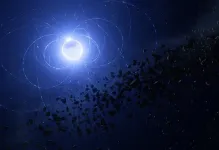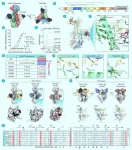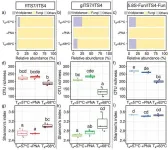(Press-News.org) When a star like our Sun reaches the end of its life, it can ingest the surrounding planets and asteroids that were born with it. Now, using the European Southern Observatory’s Very Large Telescope (ESO’s VLT) in Chile, researchers have found a unique signature of this process for the first time — a scar imprinted on the surface of a white dwarf star. The results are published today in The Astrophysical Journal Letters.
“It is well known that some white dwarfs — slowly cooling embers of stars like our Sun — are cannibalising pieces of their planetary systems. Now we have discovered that the star’s magnetic field plays a key role in this process, resulting in a scar on the white dwarf’s surface,” says Stefano Bagnulo, an astronomer at Armagh Observatory and Planetarium in Northern Ireland, UK, and lead author of the study.
The scar the team observed is a concentration of metals imprinted on the surface of the white dwarf WD 0816-310, the Earth-sized remnant of a star similar to, but somewhat larger than, our Sun. “We have demonstrated that these metals originate from a planetary fragment as large as or possibly larger than Vesta, which is about 500 kilometres across and the second-largest asteroid in the Solar System,” says Jay Farihi, a professor at University College London, UK, and co-author on the study.
The observations also provided clues to how the star got its metal scar. The team noticed that the strength of the metal detection changed as the star rotated, suggesting that the metals are concentrated on a specific area on the white dwarf’s surface, rather than smoothly spread across it. They also found that these changes were synchronised with changes in the white dwarf’s magnetic field, indicating that this metal scar is located on one of its magnetic poles. Put together, these clues indicate that the magnetic field funneled metals onto the star, creating the scar [1].
“Surprisingly, the material was not evenly mixed over the surface of the star, as predicted by theory. Instead, this scar is a concentrated patch of planetary material, held in place by the same magnetic field that has guided the infalling fragments,” says co-author John Landstreet, a professor at Western University, Canada, who is also affiliated with the Armagh Observatory and Planetarium. “Nothing like this has been seen before.”
To reach these conclusions, the team used a ‘Swiss-army knife’ instrument on the VLT called FORS2, which allowed them to detect the metal scar and connect it to the star’s magnetic field. “ESO has the unique combination of capabilities needed to observe faint objects such as white dwarfs, and sensitively measure stellar magnetic fields,” says Bagnulo. In their study, the team also relied on archival data from the VLT’s X-shooter instrument to confirm their findings.
Harnessing the power of observations like these, astronomers can reveal the bulk composition of exoplanets, planets orbiting other stars outside the Solar System. This unique study also shows how planetary systems can remain dynamically active, even after 'death'.
Notes
[1] Previously, astronomers have observed numerous white dwarfs polluted by metals that were scattered over the surface of the star. These are known to originate from disrupted planets or asteroids that veer too close to the star, following star-grazing orbits similar to those of comets in our Solar System. However, for WD 0816-310, the team is confident that vaporised material was ionised and guided onto the magnetic poles by the white dwarf's magnetic field. The process shares similarities to how auroras form on Earth and on Jupiter.
More information
This research was presented in a paper titled “Discovery of magnetically guided metal accretion onto a polluted white dwarf” to appear in The Astrophysical Journal Letters (doi:10.3847/2041-8213/ad2619).
The team is composed of Stefano Bagnulo (Armagh Observatory & Planetarium, UK [Armagh]), Jay Farihi (Department of Physics and Astronomy, University College London, UK), John D. Landstreet (Armagh; Department of Physics & Astronomy, Western University, Canada), and Colin P. Folsom (Tartu Observatory, University of Tartu, Estonia).
The European Southern Observatory (ESO) enables scientists worldwide to discover the secrets of the Universe for the benefit of all. We design, build and operate world-class observatories on the ground — which astronomers use to tackle exciting questions and spread the fascination of astronomy — and promote international collaboration for astronomy. Established as an intergovernmental organisation in 1962, today ESO is supported by 16 Member States (Austria, Belgium, Czechia, Denmark, France, Finland, Germany, Ireland, Italy, the Netherlands, Poland, Portugal, Spain, Sweden, Switzerland and the United Kingdom), along with the host state of Chile and with Australia as a Strategic Partner. ESO’s headquarters and its visitor centre and planetarium, the ESO Supernova, are located close to Munich in Germany, while the Chilean Atacama Desert, a marvellous place with unique conditions to observe the sky, hosts our telescopes. ESO operates three observing sites: La Silla, Paranal and Chajnantor. At Paranal, ESO operates the Very Large Telescope and its Very Large Telescope Interferometer, as well as survey telescopes such as VISTA. Also at Paranal ESO will host and operate the Cherenkov Telescope Array South, the world’s largest and most sensitive gamma-ray observatory. Together with international partners, ESO operates ALMA on Chajnantor, a facility that observes the skies in the millimetre and submillimetre range. At Cerro Armazones, near Paranal, we are building “the world’s biggest eye on the sky” — ESO’s Extremely Large Telescope. From our offices in Santiago, Chile we support our operations in the country and engage with Chilean partners and society.
Links
Research paper
Photos of the VLT
For journalists: subscribe to receive our releases under embargo in your language
For scientists: got a story? Pitch your research
Contacts
Stefano Bagnulo
Armagh Observatory and Planetarium
Armagh, UK
Tel: +44 (0)28 3752 3689
Email: Stefano.Bagnulo@Armagh.ac.uk
Jay Farihi
Department of Physics & Astronomy, University College London
London, UK
Email: j.farihi@ucl.ac.uk
John Landstreet
Department of Physics & Astronomy, University of Western Ontario and Armagh Observatory and Planetarium
London and Armagh, Canada and UK
Email: jlandstr@uwo.ca
Bárbara Ferreira
ESO Media Manager
Garching bei München, Germany
Tel: +49 89 3200 6670
Cell: +49 151 241 664 00
Email: press@eso.org
END
Metal scar found on cannibal star
2024-02-26
ELSE PRESS RELEASES FROM THIS DATE:
Treating adolescent opioid use disorder in primary care
2024-02-26
About The Study: This survey study found that primary care pediatricians felt less prepared to manage adolescents’ opioid use disorder (OUD) than alcohol, cannabis, or e-cigarette use and were more likely to refer them to offsite care. These results reveal an opportunity for greater workforce training in line with a 2019 survey showing fewer than 1 in 3 pediatric residency programs included education on prescribing OUD medications.
Authors: Scott E. Hadland, M.D., M.P.H., M.S., of Mass General for Children in Boston, is the corresponding author.
To access the embargoed study: Visit our For The ...
Use of tobacco products and suicide attempts among elementary school–aged children
2024-02-26
About The Study: The findings of this study of 8,988 preadolescent children suggest that the increased risk of suicide attempts, consistently reported for adolescents and adults who smoke cigarettes, extends to a range of emerging tobacco products and manifests among elementary school–aged children. Further investigations are imperative to clarify the underlying mechanisms and to implement effective preventive policies for children.
Authors: Phil H. Lee, Ph.D., of Massachusetts General Hospital and Harvard Medical School in Boston, is the corresponding author.
To ...
Study of 1.2+M births in Sydney, Australia reveals associations between excess heat exposure and preterm births
2024-02-26
In the face of increasing temperatures globally, a new Monash-led study of 1.2 million births in Sydney over two decades has shown a strong association between the risk of pre-term birth and exposure to extreme hot temperatures in the third trimester of pregnancy. The data suggested that this association with extreme temperature might be reduced by the level of greenery in a pregnant person’s residential surrounds.
The findings suggest health services should consider preparing for an increase in preterm births as our climate warms.
The study, published in JAMA Pediatrics, looked at the relationship ...
Blindness from some inherited eye diseases may be caused by gut bacteria
2024-02-26
Sight loss in certain inherited eye diseases may be caused by gut bacteria, and is potentially treatable by antimicrobials, finds a new study in mice co-led by a UCL and Moorfields researcher.
The international study observed that in eyes with sight loss caused by a particular genetic mutation, known to cause eye diseases that lead to blindness, gut bacteria were found within the damaged areas of the eye.
The authors of the new paper, published in Cell and jointly led by researchers in China, say their findings suggest that the genetic mutation may relax the body’s defences, thus allowing harmful bacteria to reach the eye and cause blindness.
The gut contains trillions ...
Journal of Pharmaceutical Analysis articles provide novel insights into previously unknown disease mechanisms
2024-02-26
DCM is the leading cause of heart failure in patients with chronic diabetes. However, the underlying mechanisms of DCM are poorly understood, and treatment options are limited. Another mystery is the regulation of cytochrome P450 enzymes (CYPs) in the central nervous system. Moreover, the link between the gut microbiome, microbiota-derived metabolites, and the progression of AD remains unknown. In the December issue of JPA, three articles provide insights into the pathologies of DCM, hippocampal neurotoxicity, and AD, providing a comprehensive ...
Enhancing electrogenerated chemiluminescence of an iridium complex
2024-02-26
Electrogenerated chemiluminescence (ECL) cells, characterized by their self-emissive nature, have gathered significant interest for prospective display applications due to their uncomplicated structure and straightforward fabrication process. These cells are created by sandwiching a solution-based emitting layer between two transparent electrodes. Nevertheless, when compared to other self-emissive devices like light-emitting diodes (LED) and organic LEDs, the luminescent performance of ECL cells ...
The structure of HSV-1 gB bound to a potent neutralizing antibody reveals a conservative antigenic domain across herpesviruses
2024-02-26
Human herpesviruses comprise the alpha, beta, and gamma subfamilies and are a widely prevalent group of DNA-enveloped viruses, capable of establishing lifelong latent infections in humans and causing various diseases. Among them, herpes simplex virus (HSV) belongs to the alpha herpesvirus group and infects a wide population, causing symptoms like oral or genital herpes. As an enveloped virus, HSV possesses a series of glycoproteins involved in virus recognition, adhesion, and infection processes. Among these, gB serves as the viral fusion protein, mediating the fusion between the virus and host cell membranes, and ...
Fighting the flu: The surprising power of a century-old vaccine for tuberculosis
2024-02-26
As Canada’s flu season collides with record strep A cases and ongoing COVID-19 concerns, a new study is shedding light on our understanding of respiratory immune responses. Scholars from the Research Institute of the McGill University Health Centre (RI-MUHC) have discovered a surprising facet about a century-old vaccine for tuberculosis, Bacillus Calmette Guérin (BCG). The study, published in the journal Nature Immunology, uncovered a previously unknown mechanism that extends the vaccine’s shield to combat influenza A virus—the most prevalent flu strain.
“The immune interactions ...
The effects of primer pairs, PCR conditions, and peptide nucleic acid clamps on plant root fungal diversity assessment
2024-02-26
Fungi are frequently found both around and within plant tissues (especially in roots) and are involved in both plant nutrient acquisition and resistance to pathogens. Thus, characterizing the diversity and composition of plant-associated fungal communities has been a growing interest in recent years.
High-throughput sequencing (HTS), also called metabarcoding, has become a prominent tool to assess complex microbial communities from environmental samples. However, HTS applied to plant-associated ...
Can hunger be eradicated by 2030?
2024-02-26
World hunger is growing at an alarming rate, with prolonged conflicts, climate change, and COVID-19 exacerbating the problem. In 2022, the World Food Programme helped a record 158 million people. On this trajectory, the United Nations’ goal to eradicate hunger by 2030 appears increasingly unattainable. New research at McGill University shines the spotlight on a significant piece of the puzzle: international food assistance.
With no global treaty in place, food aid is guided by a patchwork of international agreements and institutions. Using the concept of a “regime ...






